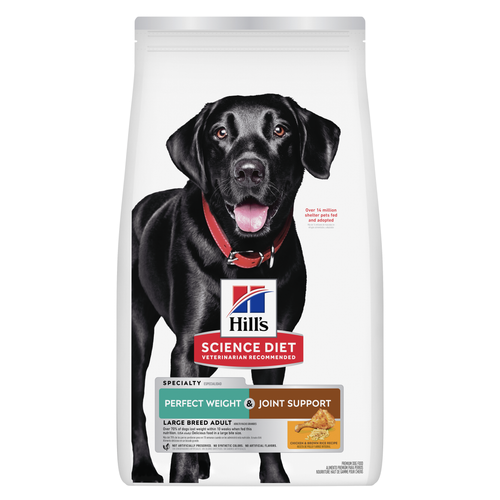
-
Find the right food for your petTake this quiz to see which food may be the best for your furry friend.Find the right food for your petTake this quiz to see which food may be the best for your furry friend.Health CategoryFeatured products
 Adult Salmon & Brown Rice Recipe Dog Food
Adult Salmon & Brown Rice Recipe Dog FoodSupports lean muscle and beautiful coat for adult dogs
Shop Now Adult 7+ Healthy Cuisine Roasted Chicken, Carrots & Spinach Stew Dog Food
Adult 7+ Healthy Cuisine Roasted Chicken, Carrots & Spinach Stew Dog FoodDelicious roasted chicken paired with tender vegetables in a succulent stew
Shop Now Perfect Weight & Joint Support Large Breed Chicken & Brown Rice Recipe Dog Food
Perfect Weight & Joint Support Large Breed Chicken & Brown Rice Recipe Dog FoodThis weight management and mobility support dog food was created with Hill’s unique understanding of the biology of overweight dogs
Shop NowFeatured products Adult Perfect Weight with Chicken Cat Food
Adult Perfect Weight with Chicken Cat FoodBreakthrough nutrition for your cat’s healthy weight maintenance and long-lasting weight support
Shop Now Adult Urinary Hairball Control Tender Chicken Dinner Cat Food
Adult Urinary Hairball Control Tender Chicken Dinner Cat FoodPrecisely balanced nutrition to support urinary health from kidney to bladder. With natural fibre technology to help reduce hairballs.
Shop Now Adult Salmon & Brown Rice Recipe Cat Food
Adult Salmon & Brown Rice Recipe Cat FoodSupports lean muscle and beautiful fur for adult cats
Shop Now -
DogCat
- Cat Tips & Articles
-
Health Category
- Weight
- Skin & Food Sensitivities
- Urinary
- Digestive
- Kidney
- Dental
- Serious Illness
-
Life Stage
- Kitten Nutrition
- Adult Nutrition
Featured articles Pet Food Storage Tips
Pet Food Storage TipsWhere you store your cat and dog food can make a big difference in the quality and freshness once it is opened. Here are some common questions and recommendations for optimal storage for all of Hill’s dry and canned cat and dog food.
Read More Water
WaterWater is the most important nutrient of all and essential for life. Animals can lose almost all their fat and half their protein and still survive, but if they lose 15% of their water, it will mean death.
Read More The Right Diet For Your Pet
The Right Diet For Your PetLearn what to look for in healthy pet food & nutrition, including ingredients, quality of the manufacturer, your pet's age, and any special needs they have.
Read More -


Many people are surprised to learn that just like in people, cancer in dogs is a real problem. An Italian study from the journal BioMed Central Veterinary Research estimated that out of every 100,000 dogs, 800 to 900 will develop cancer. Dogs older than 10 and purebreds are at increased risk compared to mixed breeds.
Cancer affects dogs in the same way that it affects humans: stealing quality of life and years away from our furry friends. However, many treatments are available and veterinary research continues to improve every dog's possibilities at a long and happy life. Learn how to spot the signs so that you and your veterinarian can give your pup the best possible care if he ever needs it.

Types of Cancer in Dogs
Cancer in dogs can affect any and every organ in the body. Dog tumors on the skin may be lumpy and obvious, but cancer in the chest, brain, abdomen or blood can be more difficult to identify. According to the American Animal Hospital Association (AAHA), the most common types of cancer in dogs include:
- Lymphoma: Cancer of the lymph nodes that attacks the immune system
- Hemangiosarcoma: Cancer of the blood vessels
- Mast cell tumor: Cancer that can develop almost anywhere in the body but is often visible as a skin lesion
- Melanoma: Aggressive skin cancer that can develop in the mouth, eyes or foot pads
- Osteosarcoma: Malignant bone cancer, most common in large dogs
- Mammary gland carcinoma: Cancer of the mammary glands that can often be prevented by spaying a female dog early in life


Tasty Tips
Signs of Cancer in Dogs
The signs of cancer in dogs vary with what system the cancer is attacking or arising from, and whether it is benign and solitary, or malignant and spreading to distant areas in the body. For example, a lipoma, a common benign tumor of fat cells, shows up as a soft, movable lump under the skin. Mast cell tumors, on the other hand, can show up as red, angry skin bumps that look like an allergic reaction. Hemangiosarcoma, a cancer arising from the cells that line blood vessels, can show up as skin tumors or can spread to the spleen (and in some cases originate in the spleen), causing it to become enlarged, lumpy and fragile.
Keep a close eye on your dog's behaviours if you think he may be sick. Limping, a swollen leg or excessively licking a leg may indicate bone cancer, while cancer in the brain can cause abnormal behaviours or seizures. Knowing what "normal" looks like for your pup's mouth, paws, neck and joints can also help you spot abnormalities. Melanoma, for instance, can show up as a dark spot in your dog's mouth or a swollen paw. The first sign of lymphoma is often a swollen lymph node or lymph nodes in the neck or knees, the AAHA writes.
Malignant cancer in dogs tends to cause unexpected weight loss, and that may be the only visible sign. If you are concerned that your pet might have cancer, call your vet and schedule a physical exam for your dog as soon as possible.
Treatment Options for Dog Tumors
Cancer in dogs is a common problem, and there are many treatment options available. Because dog and human cancers are so similar, much of the research in human cancer treatment has already been done in dogs, and nearly all of the options for human oncology treatment are available for canine patients, as well.
The treatment for cancer in dogs depends on the type of cancer and whether it is likely to spread. If a tumor is malignant, then treatment and prognosis depends on how far it has spread. The location of dog tumors can also influence what treatment your vet prescribes.
Many treatments work synergistically, meaning they build on each other and fight cancer better together than separately. Your vet or veterinary oncologist (Yes, there is such a person!) can prescribe any or all of the following:
- Surgical removal of cancerous tumors
- Radiation treatment to kill any remaining cancer cells
- Multiple treatments of cancer-killing medications, better known as chemotherapy. But don't worry — chemo is well-tolerated in dogs. They hardly ever get sick, and they don't lose their hair.
- Immunotherapy in the form of an anti-cancer vaccination to strengthen the immune system against invading tumor cells
- Stem cell transplants in dogs who have been diagnosed with blood cancers

Staying Hopeful
If your dog has been diagnosed with cancer, it can be very scary, but there are now more ways than ever to treat and even cure cancer in many canine patients. Many pet parents elect to not treat their pets because they think that the treatment will cause them discomfort, but pets tend to tolerate cancer treatment much better than most humans. This is partially because they don't know what is going on. You may dread taking your pup in for treatment, but your dog usually views it as a trip to the veterinary clinic where everybody is nice to him and gives him dog treats.
If your pet has been diagnosed with cancer, then listen to the options that your vet gives you, and choose the best one for you and your furry friend. Organisations like the National Canine Cancer Foundation can help connect you with other dog parents going through cancer treatment for suggestions and support.
As in humans, the earlier you catch cancer, the easier it is to treat, so make sure to get your dog examined by a vet at least annually to allow for early intervention if it is ever needed. Removing one "harmless" lump could give your pup many more happy years.


Dr. Sarah Wooten graduated from UC Davis School of Veterinary Medicine in 2002. A member of the American Society of Veterinary Journalists, Dr. Wooten divides her professional time between small animal practice in Greeley, Colorado, public speaking on associate issues, leadership, and client communication, and writing. She enjoys camping with her family, skiing, SCUBA, and participating in triathlons.
Related products

Delicious roasted chicken paired with tender vegetables in a succulent stew

Supports lean muscle and beautiful coat for adult dogs

Gentle on stomachs while nourishing skin & supporting development in growing puppies

This weight management and mobility support dog food was created with Hill’s unique understanding of the biology of overweight dogs
Related articles

A dog with a sensitive stomach has special needs. Learn more about sensitive stomach symptoms in your dog, what you can do to help sooth your pet’s insides and get recommendations on sensitive stomach dog food.

Though it may seem like your four-legged friend loves nothing more than to nap on the couch, dogs need regular exercise to stay healthy just like people do.

Learn what you can feed your pregnant or nursing dog to keep her and her new pups healthy.

Selecting the right food for your puppy is a key to quality nutrition and a long, healthy life., Learn more about how to select the right puppy food.

Put your dog on a diet without them knowing
Our low calorie formula helps you control your dog's weight. It's packed with high-quality protein for building lean muscles, and made with purposeful ingredients for a flavorful, nutritious meal. Clinically proven antioxidants, Vitamin C+E, help promote a healthy immune system.
Put your dog on a diet without them knowing
Our low calorie formula helps you control your dog's weight. It's packed with high-quality protein for building lean muscles, and made with purposeful ingredients for a flavorful, nutritious meal. Clinically proven antioxidants, Vitamin C+E, help promote a healthy immune system.

